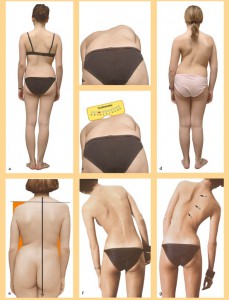Even a severe scoliosis may not create notable symptoms. This is the reason why it is seldom detected by the patient himself. Sometimes pain after heavy physical activity is noted.
The postural asymmetries so typical of scoliosis are easily detected by professionals, but can go unnoticed by the patient and his parents for a long time. The most important asymmetries are:
- shoulders are not level
- tilted pelvis (pelvis is not level)
- asymmetrical waistline between the arms and torso
- a prominent shoulder blade
- a rib hump
- pelvis shifted to one side
A typical sign is the formation of a rib hump which is due to vertebral rotation and the distortion of the rib cage. This can be best revealed – even to the untrained eye – during forward bending.
Keeping the legs straight, have the child bend forward. A healthy back will be symmetric on both sides. If one side appears higher than the other, this is caused by the rotation of the spine or torsion of the rib cage.
According to the level at which the most spinal rotation and sideward deviation occurs, scoliosis is divided into a thoracic, thoracolumbar or lumbar type.
If scoliosis is suspected, it is necessary to have an x-ray taken in order to assess the deformation in more detail and to measure the Cobb angle.
If the curve is less than 10 degrees, then it is called a scoliotic posture or a functional scoliosis. This is an asymmetrical posture exhibited by children who have problems with the coordination of their back muscles. The spine is slightly deviated to the side, but has not yet rotated and does not exhibit vertebral torsion. Slight scolioses can disappear of themselves. However, a scoliotic posture during a growth spurt can turn into a real, structural scoliosis. Therefore specific treatment should deal with the detected asymmetries, and repeated visits to the doctor every 3-6 months is recommended. A structural scoliosis has a tendency to progress.


